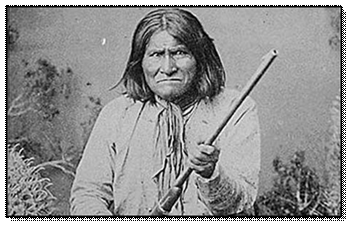
Geronimo (June 16, 1829 – February 17, 1909), often spelled Goyathlay or Goyahkla in English, was a prominent Native American leader and medicine man of the Chiricahua Apache who fought against Mexico and the United States and their expansion into Apache tribal lands for several decades during the Apache Wars. Geronimo’s parents raised him according to Apache traditions; after the death of his father his mother took him to live with the Chihenne. He married a woman from the Nedni-Chiricahua band of Apache when he was seventeen; they had three children. In 1858 a company of Mexican soldiers attacked Geronimo’s camp while the men were away and among those killed were his wife, children and mother. His chief, Mangas Coloradas, sent him to Cochise’s band for help in revenge against the Mexicans. It was the Mexicans who named him Geronimo, stemming from a battle in which, ignoring a hail of bullets, he repeatedly attacked Mexican soldiers with a knife, causing them to utter appeals to Saint Jerome (“Jeronimo!”). Geronimo never called himself a chief but was a military leader. As a Chiricahua Apache, this meant he was one of many people with special spiritual insights and abilities known to Apache people as ‘Power’. Among these were the ability to walk without leaving tracks, the abilities now known as telekinesis and telepathy, and the ability to survive gunshot wounds. Geronimo was wounded several times by both bullets and buckshot but survived. Apache men chose to follow him of their own free will, and offered first-hand eye-witness testimony of his many ‘powers’.
Geronimo married several times during his life, fathering a number of children. Some of these wives were captured or were lost in his travels; others came and went for various reasons. At the end of his military career, he led a small band of 36 men, women and children. They evaded thousands of Mexican and American troops for over a year, making him the most famous Native American of all time and earning him the title of the ‘worst Indian who ever lived’ among white settlers. His band was one of the last major forces of independent Native American warriors who refused to acknowledge the United States occupation of the American West.
Numerous stories abound as to who actually captured Geronimo, or to whom he surrendered, although most contemporary records, and Geronimo’s own later statements, give most of the credit for negotiating the surrender to Lieutenant Charles B. Gatewood. The debate still remains whether Geronimo surrendered unconditionally. Geronimo pleaded in his memoirs that his people had been misled. In his old age, Geronimo became a celebrity. He appeared at fairs, including the 1904 World’s Fair in St Louis where he reportedly rode a Ferris wheel and sold souvenirs and photographs of himself. However, he was not allowed to return to the land of his birth. In 1905, Geronimo agreed to tell his story to S.M. Barrett, Superintendent of Education in Lawton, Oklahoma. Barrett had to obtain permission from President Roosevelt to publish the book. Geronimo came to each interview knowing exactly what he wanted to say. He refused to answer questions or alter his narrative.
In February, 1909, Geronimo was thrown from his horse while riding home and had to lie in the cold all night before a friend found him extremely ill. He died of pneumonia on February 17, 1909 as a prisoner of the United States at Fort Sill, Oklahoma. On his deathbed he confessed to his nephew that he regretted his decision to surrender. He was buried at Fort Sill in the Apache Indian Prisoner of War Cemetery. ‘Geronimo’ –
National Geographic Magazine 182, October 1992.
Geronimo: a Biography – Alexander B. Adams, 1990, Da Capo Press.